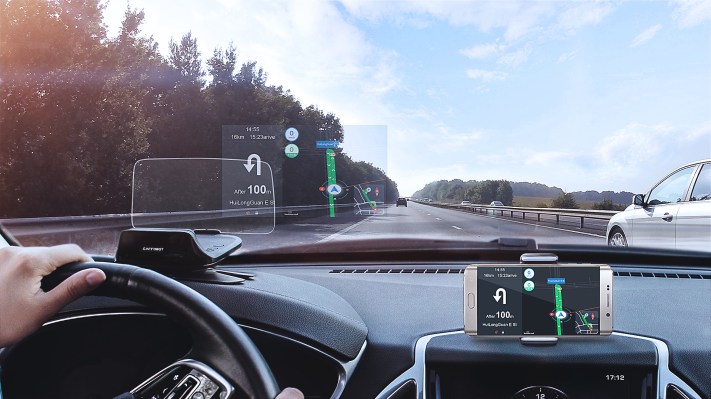If you want to add a head-up display (HUD) to your car, you’ve certainly got choices. In addition to Navdy and its Chinese clone Roav, Carrobot launched in October to bring its eye-level interface to cars that don’t have the tech built in.
Carrobot distinguishes itself from its competitors, most notably Navdy and Exploride, by having full voice control for all functions as well as a Bluetooth remote control. All three can handle the expected functions, like GPS navigation, phone calls, messaging, and music; Carrobot and Exploride are also wifi hotspots via the OBD-II port plug-in, and they’ll provide additional alerts from your phone.
All of this is possible because these aftermarket HUDs use your phone plus information from your car, if it’s connected via the OBD-II port. You position the device on the dashboard between the steering wheel and the windshield, and connect it to your phone and car. The device projects information from your onto a clear screen, which makes it appear as if the information is hovering in space in front of your car. Carrobot even performs some driving assistance tasks, like letting you know if you’re straying from your lane.
Carrobot is in the crowdfunding stage on Indiegogo, with an estimated shipping date of March 2017. It’s already shipped a first version to the Chinese market, so it expects to be able to hit this North American target date without delays. (Navdy, we’re looking at you.) Carrobot starts at $199, with more feature-filled versions at $399 and $499.
HUDs are becoming more available as an option baked right into vehicles at the factory, but the technology has been around for years. Early HUDs were in luxury cars like Audis, BMWs, and Cadillacs, but the systems are finding their way into less expensive cars. A press release from March 2015 noted that at the time, 30% of all GM vehicles sold in North America were equipped with a head-up display.
But as people transition to new automotive technology faster than they buy new cars, aftermarket HUDs are likely to gain traction. These devices also take into account consumers’ preference for using their own apps on their own phone in their cars. It’s on the aftermarket manufacturers to make the experience as seamless as it would be with a built-in system.
